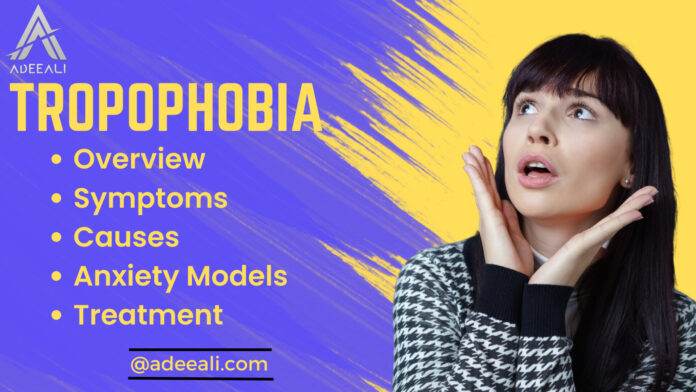Have you ever met someone who is really terrified of moving or making any changes in his/her life? Do you wonder what causes such a strong fear of change? In this article, we are going to study Tropophobia, its forms, symptoms, causes, treatment and different models of anxiety that occur in it.
What is Tropophobia?
In Greek literature, tropos mean “to turn, direction” and phobia means “an unrealistic fear or anxiety of something”. So as a whole, we define tropophobia as a feeling of fearfulness that one feels while making any change in his life.
These people have moving anxiety. It is an exaggerated form of illogical fear that stops oneself from doing something new. So, whenever these sufferers try or just think of trying a new experience, they start facing anxiety. And as anxiety sucks, its victims start avoiding those things.

As they are afraid of change, they tend to avoid all forms of change, which consequently limit their personal and professional growth. It’s like they’re held back by their fear. In the worst case scenario, they can even take this to the extreme by completely restricting themselves from doing anything.
Difference between Trypophobia vs Tropophobia :
Trypophobia is defined as fear of holes, while on the other hand Tropophobia is a fear of making changes.

Trypophobia is a term used to describe an intense aversion to clustered patterns of small holes or bumps. Moreover, people suffering from this phobia usually feel disgusted when looking at these patterns.
These patterns often appear in natural objects like beehives, strawberries, lotus seeds, coral reefs etc. It can also be triggered by looking at lesioned skin. Some people suffer from hair transplant trypophobia, because a pattern of holes is made on scalp in this technique.
Forms of Tropophobia :
We have already discussed one form. The other form has something to do with language and literature. As we mentioned above, in Greek language tropos mean “to turn”, but in English language “trope” is a term used for metaphor which is technically a type of figurative language.
So trope is a word used to create a powerful image in a text. In this context, it is defined as the fear of using tropes in your writing. This meaning is not so common but still it has been used in some literature work as in The Poetics of Mind: Figurative Thought, Language, and Understanding ( a book by Raymond Gibbs ).
Symptoms :
One of the key aspects in understanding a disease is recognizing its symptoms, which tell about the presence or progression of the condition.
Whenever these people think or try to have some change in their daily routine, they usually suffer from :
- Anxiety
- Tachycardia (increased heart rate)
- Palpitations
- Pupil Dilation
- Nausea (urge to vomit)
- Unable to cope with their anxiety
- Muscle tension
- Tremors or shakiness
- Sweating
- Panic attacks
Now you must be thinking that these symptoms are very general and they occur usually in many other medical conditions. Isn’t it ?
Of Course it is ! And you are right in this stance. Actually, these symptoms are the symptoms of our sympathetic nervous system which gets activated in stressful conditions. Whenever there is a “fight or flight” situation, our body acts the same way.
Causes :
As symptoms were not specific enough to describe this condition, we’ll need to go through its causes. Understanding the cause of a disease is essential to know about its development, incidence and treatment as well.
There could be a lot of causes of tropophobia, which varies from person to person but generally they are divided into two groups :
Genetic factors :
These factors are present in genes/DNA of a person which has been genetically transferred to him from his ancestors. A person who has a family history of mental disorders is more likely to be afraid of change . Accordingly, some people are more sensitive than others.
Environmental factors :
It includes all the experiences that a person has experienced in his life. Someone who faced an unpleasant experience when something new or different happened in his life will develop its fear. Now his brain has learned that whenever this thing would happen again it would hurt him.

How does it occur ?
Now you must be wondering how this fear system works in our brain. To quench this thirst let’s dive into the psychology of the human brain.
According to a research, it has been found that both humans and infants respond with agitation and fear to a rapid visual approach of a threat stimulus. Whenever something enters rapidly in our radar circle, we become attentive and cautious. It is one of our basic instincts. Most probably there is exaggeration of this instinct in victims of tropophobia.
An abundance of evidence has proved that fear is influenced by the expectations which individuals have about the probability or severity of harm and not just by the objective status of danger. Actually, it’s a defect of their perception.
As written in a book (Moving Makes it Worse: The Role of Rapid Movement in Fear of Psychiatric Patients), the perception of threat movement usually dominates and results in the fear and appraisal of a source of danger that is imminent and likely to result in harm.
Harm Looming model :
John Riskind has proposed an anxiety model named as “Harm Looming model” in this book, which affirms that individual’s perceptions play a key role in cognition of threat movement.
The person’s perception of movement evokes fear because the loomingness or forward movement of a threat can rapidly increase the apparent physical proximity of that threat.
Appraisal Theory by LAZARUS :
Richard Lazarus was one of the first modern theorists to propose the concept of appraisal as essential to the study of anxiety and stress. According to this theory, stress is a two-way process; it involves the interaction with stress stimuli from the environment, and the response of an individual to these stimuli
Emphasizing on Lazarus model, Beck and Emery proposed that there are 2 types of appraisals in anxious individuals :
- Primary appraisal (perceive excessive threat or danger)
- Secondary appraisal (underestimate their degree of control or effectiveness in coping with this threat).
Looming vulnerability model and Tropophobia :
This model holds a different concept towards anxiety. Looming vulnerability is conceptualized as an important cognitive component of threat that elicits anxiety, sensitizes the individual to signs of movement. Resultantly, anxiety sucks and makes it less likely for victims to habituate.
The central meaning depicted by this model is that a rapidly moving threat mimics a body in motion. This experience in which threat appears to our minds as a body in a state of motion is the core of cognitive anxiety.
The model tells that the person who appraises threats as rapidly growing or coming has a painful sense of looming vulnerability to harm. The sense of looming vulnerability will elicit greater anxiety without reference to whether there is an actual looming threat or it is imaginary.
In comparison, an object perceived as sitting inertly in one place will elicit minimal levels of anxiety. That’s why tropophobic victims are afraid of movements.
Negative impacts of Tropophobia :
The fear of moving and making changes can have various negative impacts on individuals. Here are some common negative consequences :
- Missed opportunities for personal growth: This phobia restricts individuals from stepping out of their comfort zones and experiencing personal growth. That’s why they have stunted personal growth.
- Limited professional opportunities: Career progression often requires abrupt changes such as taking on new responsibilities, seeking advancement and exploring different industries. Or we can simply say that being adventurous is a key to professional growth. As tropophobic patients are afraid of changing positions so they miss most of the professional opportunities.
- Strained relationships: The fear of moving on or making changes can affect relationships, particularly when one partner is more open to change than the other. This mismatch in attitudes create tension in healthy relationships.

Tropophobia and relationships :
Relationships require open communication and the willingness of both partners to address issues as they arise. However, if one of the partners is tropophobic, he would try to avoid discussing those issues.
It creates a communication gap and the issues remain unsolved, which results in quarrelsome behavior of the other partner. Here are some tips about how you can handle this situation and make your partner calm.
Treatment of Tropophobia :
After reading this whole description about tropophobia, now you are able to judge whether someone is suffering from tropophobia or not. If you think you yourself or someone in your social circle is tropophobic then here are some treatment methods which you can apply to alleviate the condition :
Causative treatments :
In this, we use therapies that treat the underlying cause.
-
Cognitive-Behavioral Therapy (CBT):
You would have heard of this term a lot and you’d be curious to know what principle underlies cognitive behavioral therapy. Lets get into it !
It is a widely recognized therapeutic approach for anxiety disorders. It involves identifying and challenging the negative thoughts.
Cognitive restructuring is the main goal to achieve in CBT. In this technique, the perception and thought-process of the patient is modified to make him believe this statement “ Don’t be afraid of change ”. As a result, patients learn to reframe their thoughts and develop strategies about How to manage their anxiety.
-
Exposure Therapy:
Exposure therapy focuses on gradually exposing the individuals to their feared stimuli. In this case, exposure therapy involves gradually introducing changes or new environments in a controlled and supportive manner.
They are told that “ your anxiety is lying to you “. This gradual exposure helps desensitize individuals to their fear and teaches them that this change is manageable and not threatening at all.
Symptomatic Treatment :
In this treatment, we target symptoms and then apply specific techniques to specific symptoms.
- The most common symptom is “anxiety”. We treat it by Mindfulness-based techniques such as meditation, yoga or deep breathing exercises. These techniques can help individuals cultivate a non-judgmental attitude towards change.
- Regular exercise ( to reduce muscle tension )
- A balanced diet ( to treat nausea and indigestion )
- Sufficient sleep ( to calm down your brain )
Conclusion:
Tropophobia can have significant effects on individuals’ well-being, impacting their personal, professional, and relational lives. Those experiencing this phobia usually feel overwhelmed by anxiety, palpitations, and other symptoms mentioned above.
Various psychological models, like the Harm Looming Model and the Looming Vulnerability Model, provide insights into how individuals perceive and respond to the threat of change.
Thankfully, effective treatments are available to help individuals overcome this phobia and regain control over their lives.If you or someone you know is struggling with tropophobia, don’t hesitate to seek support.
With the right guidance and strategies, it’s possible to overcome this fear and ultimately get new opportunities for growth and fulfillment.
CTA (Call to Action):
Do you want to conquer this fear of change and live a more fulfilling life? Reach out to a licensed therapist or counselor today to explore personalized treatment options. You don’t have to face this challenge alone – take the first step towards a brighter future now!
FAQs :
What is tropophobia the fear of?
It is the fear of moving on or making any changes in your usual routine. The fear of doing something new.
How tropophobia affects relationships?
If one or both partners in a relationship have this fear of moving or making changes, they would be hesitant to relocate to new living arrangements or to make any new decisions. This reluctance would have a negative impact on the growth of their relationship.
What is the cause of Tropophobia?
An irrational expectation of harm which could occur as a result of some change is its main cause.

